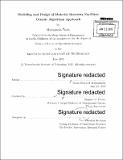| dc.contributor.advisor | Stephen C. Graves. | en_US |
| dc.contributor.author | Testa, Mariapaola | en_US |
| dc.contributor.other | Massachusetts Institute of Technology. Operations Research Center. | en_US |
| dc.date.accessioned | 2015-09-17T19:06:59Z | |
| dc.date.available | 2015-09-17T19:06:59Z | |
| dc.date.copyright | 2015 | en_US |
| dc.date.issued | 2015 | en_US |
| dc.identifier.uri | http://hdl.handle.net/1721.1/98715 | |
| dc.description | Thesis: S.M., Massachusetts Institute of Technology, Sloan School of Management, Operations Research Center, 2015. | en_US |
| dc.description | Cataloged from PDF version of thesis. | en_US |
| dc.description | Includes bibliographical references (pages 187-193). | en_US |
| dc.description.abstract | In the Organisation for Economic Co-operation and Development (OECD) area, the production of numerical solid waste (MI\SW) increased by 32% between 1990 and 2011, exceeding 660 million tonnes in 2011; the world-wide production of waste is estimated to grow further due to increasing GDP in developing economies. Given this scenario, effective treatment and recovery of wastes becomes a priority. In developed countries, MSW is usually sent to materials recovery facilities (MRFs), which use mechanical and manual sorting units to extract valuable components. In this work, we define a network flow model to represent a MRF that sorts wastes using multi-output units with recirculating streams. For each material in the system, we define a matrix to describe the sorting process. We then formulate a genetic algorithm (GA) that generates alternative configurations of a MRF having a given set of sorting units with known separation parameters and selects those with highest profit and efficiency. The GA incorporates a heuristic for personnel allocation to manual units. We code the algorithm in Java and apply it to an existing MRF. The results show a 33.4% improvement in profit and a 1.7% improvement in efficiency with respect to the current configuration without hand sorting; and a 6.7% improvement in profit and a 3.9% improvement il efficiency, with respect to the current configuration with hand sorting. | en_US |
| dc.description.statementofresponsibility | by Mariapaola Testa. | en_US |
| dc.format.extent | 193 pages | en_US |
| dc.language.iso | eng | en_US |
| dc.publisher | Massachusetts Institute of Technology | en_US |
| dc.rights | M.I.T. theses are protected by copyright. They may be viewed from this source for any purpose, but reproduction or distribution in any format is prohibited without written permission. See provided URL for inquiries about permission. | en_US |
| dc.rights.uri | http://dspace.mit.edu/handle/1721.1/7582 | en_US |
| dc.subject | Operations Research Center. | en_US |
| dc.title | Modeling and design of material recovery facilities : genetic algorithm approach | en_US |
| dc.title.alternative | Material recovery facilities : genetic algorithm approach | en_US |
| dc.type | Thesis | en_US |
| dc.description.degree | S.M. | en_US |
| dc.contributor.department | Massachusetts Institute of Technology. Operations Research Center | |
| dc.contributor.department | Sloan School of Management | |
| dc.identifier.oclc | 920691527 | en_US |
